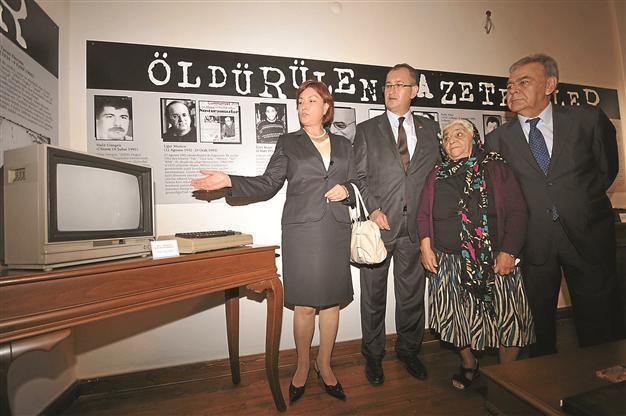Memories of murdered journalists at a museum
İZMİR - Doğan News Agency

The Press museums display personal objects of the murdered journalists such as Uğur Mumcu’s first computer and Metin Göktepe’s
sweater. DHA photo
İzmir Metropolitan Municipality has opened a new press museum that will better acquaint visitors with the profession while also honoring the memory of Turkish journalists murdered in the course of their work.
“Journalists who tried to illuminate their society became the target of dark powers. They died because they were doing their work. They are our light and source of pride,” Atilla Sertel, the chairman of the Turkish Journalists Federation and the İzmir Journalists Association, said at the Sept. 6 opening of the Press Museum, which will be housed in the annex of the historic Ayavukla Church in the Aegean province’s Basmane neighborhood.
The facility displays the personal effects of murdered journalists including daily Hürriyet’s Çetin Emeç, daily Milliyet’s Abdi İpekçi, daily Evrensel’s Metin Göktepe, daily Cumhuriyet’s Uğur Mumcu and Ümit Kaftancıoğlu, as well as famous intellectual Turan Dursun. Visitors to the museum will be able to peruse the murdered writers’ personal objects such as typewriters, computers, watches, waistcoats and sweaters.
Criticizing the ministerSpeaking at the opening, Güldal Mumcu, the widow of Uğur Mumcu and the current deputy speaker of the Turkish Parliament, said museums and libraries were diaries of societies that could never forget the past as she donated her late husband’s first computer.
At the same time, she took aim at Culture and Tourism Minister Ertuğrul Günay, criticizing him for the management of the conversion of Ankara’s Ulucanlar Prison into a museum. The prison, in which the famous poet Nazım Hikmet was incarcerated and Turkish revolutionary Deniz Gezmiş was executed, has been ostensibly converted into a museum, but the inmates’ writings have been erased from the walls while the gallows have been polished and turned into a piece of furniture, she said.
“Ulucanlar is no longer a prison, but it’s not a museum either,” Mumcu said, holding Günay responsible for the botched conversion and failure to present the prison’s history accurately. Meryem Göktepe, meanwhile, said she and her mother had donated a sweater belonging to her brother, Metin Göktepe, who was murdered by police in 1996. “There are hair strands of Metin on this sweater. It smells like Metin. It is a relic for us. It is now at the place where it should be.”
Ultimately, journalism is a painful business, Sertel said. “Today is important for illuminating the next generations. Journalism has stepped into a new age in terms of technology. But its social and economic conditions, syndication and life conditions have regressed. Journalists’ struggle will change this unbelievable situation. It is very meaningful for us that Güldal Mumcu gave us Mumcu’s first computer, Göktepe’s mother and sister gave us his sweater. Also, İpekçi’s typewriter, Emeç’s notes and the last threatening letter that he received before he died are on display at the museum. Do not let journalists die and be arrested from now on.”
The museum was opened as part of İzmir’s 90th anniversary celebrations of the city’s liberation from foreign occupation.
